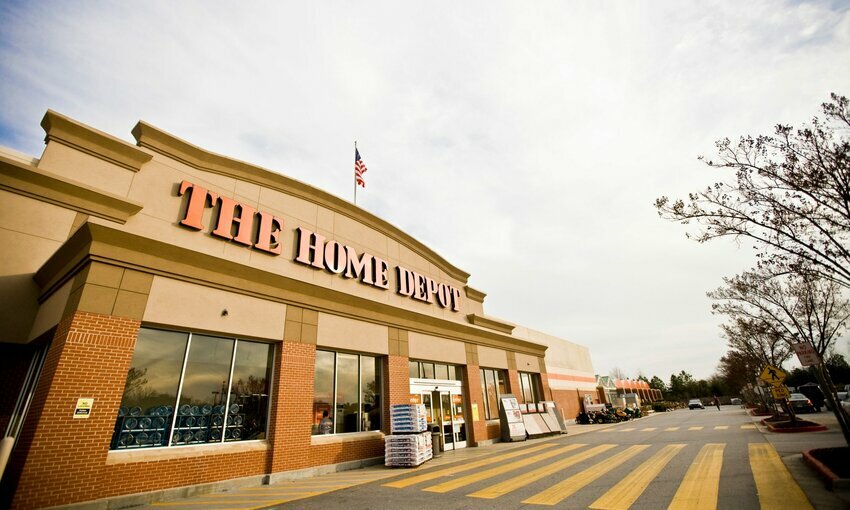 (Photo Credit: The Home Depot)
(Photo Credit: The Home Depot)The Home Depot is one of the best-known home improvement stores in the world. It sells everything — from power tools to home appliances to construction equipment. Headquartered in Atlanta, Georgia, it operates in Mexico and Canada and has nearly 500,000 employees. In 2021, it had $151 billion in revenues.
The Home Depot has recently joined the SBTi, the Science-Based Targets initiative, by establishing a clear path to reduce our emissions in line with the Paris agreement goals. The retailer is committed to reducing CO2 emissions by 50% by 2035 and running all its stores using 100% renewable energy by 2030.
At the same time, Home Depot is partnering with its suppliers to reduce virgin plastic in the products it sells. In 2019 and 2020, more than 1,200 products were redesigned to avoid such waste. Furthermore, between 2017 through 2020, the company redesigned 366 packages to reduce size and materials — something it says prevented thousands of cargo ships from setting sail.
“We are investing in renewable energies, supply chain efficiencies, and recycling programs to reduce the environmental impact of our operations. Every day, we strive to do better – to reduce our company’s environmental impact and improve the lives of the people throughout our value chain. Our commitment to operating sustainably has never been stronger,” the company says, in its sustainability report.
Can you explain your carbon reduction goals in more detail?
In 2020, the company updated its climate goals. That year, its direct emissions (Scope 1) from combustible sources and refrigerants totaled 607,000 tons. Its indirect emissions from electricity from utilities and others (Scope 2) for its operations totaled 1.2 million metric tons. And its emissions from upstream transportation and distribution of freight totaled nearly 3 million metric tons (Scope 3).
Home Depot’s stores will run entirely on renewable energy by 2030. It’s an expansion of the company’s previous goal — to buy or produce 335 megawatts of renewable or alternative energy by 2025. Solar will provide 75% of that by the end of 2023. At 53 stores, battery storage devices store solar power and release it during peak consumption to reduce energy usage and bills.
Besides using a lot more green energy to fuel its stores, Home Depot has converted to LED lighting. It installed such efficient lighting in all of its stories at the end of 2021, and it has seen electricity consumption drop by 30% as a result — compared to conventional lighting. In 2020, it installed 836 energy-efficient heating, air-conditioning, and ventilation systems in more than 70 U.S. stores. Since 2010, it says it has cut electricity consumption by 44%. In 2020, it says it reduced CO2 emissions by 22% for each dollar of revenue it earned, compared to 2019.
“We reduced Scope 1 and 2 emissions by over 127,000 metric tons in 2020, achieving a 22% year-over-year reduction in carbon dioxide emitted per dollar of revenue earned,” it says. “We have committed to reducing our Scope 1 and Scope 2 carbon dioxide emissions by 2.1% per year to achieve a 40% reduction by 2030 and a 50% reduction by 2035.”
Meanwhile, Home Depot is investing $1.2 billion to fund about 150 new supply chain facilities nationwide. As of 2020, it added 30 regional distribution hubs. That increased the speed to the final destination, reducing the miles traveled to deliver those goods.
Here’s what else the company says it does to reduce Scope 3 — supply chain — emissions:
•. Hydrogen fuel cells provide emissions-free fuel for forklifts at its supply chain facilities. It estimates that fuel cells at 12 locations in 2020 helped to reduce electricity consumption by about 16 million kilowatt hours.
• It ensures its trucks are fully loaded before each delivery through space-sharing arrangements it has with other distributors. That space sharing saves about 2 million driven miles a year.
“Running a responsible and sustainable company is foundational to our business. Doing our part creates value for all of our shareholders,” says Craig Menear, chief executive of Home Depot, in the company’s sustainability report.
Can you please explain the progress you are making in the circular economy?
Home Depot says it has adopted the repair, refurbish, and recycle policies necessary to fulfill its promises under the circular economy. It “encourages” suppliers to design packaging for reuse and longevity.
“We understand that our biggest impact on the environment comes from the products we sell,” says Ron Jarvis, chief sustainability officer at Home Depot, in the 2021 sustainability report. “We continue to work with suppliers to make products more sustainable through improvements in materials sourcing, chemistry, packaging, manufacturing, and distribution.”
He points to the partnership with Trex, which has helped Home Depot reduce its use of single-use plastics. The company says it recycled 17 million pounds of plastic, 261,000 tons of cardboard, 82,000 tons of metal, 1.2 million pounds of rechargeable batteries, and 2 million pounds of obsolete technologies. What else?